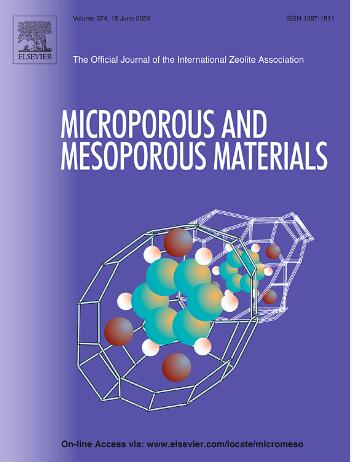Highly controllable CO2 capture performance under varied humidity conditions by finely tuned metal and organic ligand compositions of DMOF adsorbents
IF 4.8
3区 材料科学
Q1 CHEMISTRY, APPLIED
引用次数: 0
Abstract
Excessive CO2 emissions significantly contribute to global warming, promoting the advancement of carbon capture and storage (CCS) technologies. Metal-organic frameworks (MOFs) are promising candidates for selective CO2 adsorption; however, their effectiveness is often compromised in humid environments, such as flue gas streams. To overcome this limitation, this study synthesizes six isostructural DABCO-pillared MOFs (DMOFs) by finely tuning metal nodes (from Zn to Ni) and integrating methyl (-CH3) functional groups on the organic ligand to enhance CO2 adsorption performance, especially under humid conditions. Single gas adsorption isotherms reveal that the Ni-TM DMOF achieves the highest CO2 adsorption capacity of 5.0 mmol g−1 and maintains 100 % regenerability after five cycles. Binary CO2/N2 dynamic breakthrough experiments further demonstrate that the Ni-TM DMOF excels in both CO2 uptake and CO2/N2 separation performance under both dry and humid conditions (80 % relative humidity). Mechanistic insights from in situ diffuse reflectance infrared Fourier transform spectroscopy (DRIFTS) and density functional theory (DFT) calculations elucidate the molecular interactions between CO2 and the DMOF structure, revealing that CO2 adsorption predominantly occurs via physisorption, enhanced by C-H·O interaction from the -CH3 groups. This work provides a strategic approach for enhancing the stability and efficiency of MOFs in industrial CO2 sequestration applications.

通过精细调整金属和有机配体组成的DMOF吸附剂,在不同湿度条件下高度可控的CO2捕获性能
过量的二氧化碳排放是全球变暖的重要原因,促进了碳捕获与封存技术的发展。金属有机框架(mof)是一种很有前途的选择性CO2吸附材料;然而,在潮湿的环境中,如烟道气流中,它们的有效性往往受到损害。为了克服这一限制,本研究通过对金属节点(从Zn到Ni)进行微调,并在有机配体上整合甲基(-CH3)官能团,合成了六种同结构的dabco柱型mof (DMOFs),以提高二氧化碳吸附性能,特别是在潮湿条件下。单次气体吸附等温线表明,Ni-TM DMOF在5次循环后达到最高的CO2吸附量5.0 mmol g−1,并保持100%的可再生性。二元CO2/N2动态突破实验进一步证明了Ni-TM DMOF在干燥和潮湿条件下(80%相对湿度)均具有良好的CO2吸收和CO2/N2分离性能。原位漫反射红外傅立叶变换光谱(DRIFTS)和密度泛函理论(DFT)计算的机理揭示了CO2与DMOF结构之间的分子相互作用,揭示了CO2的吸附主要通过物理吸附发生,并通过-CH3基团的C-H·O相互作用增强。本研究为提高mof在工业二氧化碳固存中的稳定性和效率提供了一种战略途径。
本文章由计算机程序翻译,如有差异,请以英文原文为准。
求助全文
约1分钟内获得全文
求助全文
来源期刊

Microporous and Mesoporous Materials
化学-材料科学:综合
CiteScore
10.70
自引率
5.80%
发文量
649
审稿时长
26 days
期刊介绍:
Microporous and Mesoporous Materials covers novel and significant aspects of porous solids classified as either microporous (pore size up to 2 nm) or mesoporous (pore size 2 to 50 nm). The porosity should have a specific impact on the material properties or application. Typical examples are zeolites and zeolite-like materials, pillared materials, clathrasils and clathrates, carbon molecular sieves, ordered mesoporous materials, organic/inorganic porous hybrid materials, or porous metal oxides. Both natural and synthetic porous materials are within the scope of the journal.
Topics which are particularly of interest include:
All aspects of natural microporous and mesoporous solids
The synthesis of crystalline or amorphous porous materials
The physico-chemical characterization of microporous and mesoporous solids, especially spectroscopic and microscopic
The modification of microporous and mesoporous solids, for example by ion exchange or solid-state reactions
All topics related to diffusion of mobile species in the pores of microporous and mesoporous materials
Adsorption (and other separation techniques) using microporous or mesoporous adsorbents
Catalysis by microporous and mesoporous materials
Host/guest interactions
Theoretical chemistry and modelling of host/guest interactions
All topics related to the application of microporous and mesoporous materials in industrial catalysis, separation technology, environmental protection, electrochemistry, membranes, sensors, optical devices, etc.
 求助内容:
求助内容: 应助结果提醒方式:
应助结果提醒方式:


